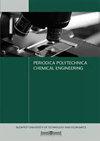表面活性剂和pH改性剂对比莫苯丹溶解和渗透的影响
IF 1.8
4区 工程技术
Q3 ENGINEERING, CHEMICAL
引用次数: 0
摘要
水溶性差的活性药物成分的溶解度和渗透性是建立其体内外相关性的关键参数。最近的研究表明,增溶剂的加入不仅会改变原料药的溶解度,还会改变原料药的有效渗透率,并且这些理化参数之间存在一定的数学关系。本研究的目的是显示在添加剂存在的情况下早期筛选溶解度和渗透性的重要性,以实现原料药的预期生物利用度。本研究重点研究了表面活性剂和微环境pH调节剂的作用,并选择匹莫苯丹作为模型药物。在pH改性剂的情况下,原料药的平衡溶解度增加,而渗透率明显降低。两种表面活性剂在较低的添加水平下对渗透率没有负面影响,但在较高的浓度下,这两种表面活性剂对渗透率也有轻微的负面影响。在同时溶透研究中,发现含表面活性剂的配方比含ph改性剂的配方具有稍高的通量。这可能是由于这种现象,这些表面活性剂可以增强活性物质的溶解,而没有明显的降低渗透性的作用。本研究的结果清楚地表明,研究药物添加剂的相互作用在配方开发的每一步的重要性,并以此为基础,选择适当的质量和数量的添加剂。此外,研究结果还强调了同时进行溶出渗透研究对预测生物利用度的重要性。本文章由计算机程序翻译,如有差异,请以英文原文为准。
The Effect of Surfactants and pH Modifying Agents on the Dissolution and Permeation of Pimobendan
Solubility and permeability are key parameters for establishing in vitro-in vivo correlation for poorly water-soluble active pharmaceutical ingredients (APIs). Recent studies demonstrate that not only solubility, but also effective permeability of the API may change due to the addition of solubilizing agents, and there is a certain mathematical relation between these physicochemical parameters. The aim of this study was to show the importance of early screening of solubility and permeability in presence of additives in order to achieve the expected bioavailability of the API. In this work, the effect of surfactants and microenvironmental pH modifiers were in focus, and pimobendan was chosen as model drug.In the case of pH modifiers, the equilibrium solubility of the API increased, while the permeability decreased significantly. No negative effect was observed for two surfactants at low additive levels, but these two additives also exhibited a slightly negative effect on permeability when used at higher concentrations. In the simultaneous dissolution-permeation studies the surfactants-containing formulation was found to have slightly higher flux than the pH-modifier-containing one. It can be due to the phenomenon that the dissolution of the active substance can be enhanced by these surfactants without any significant permeability reducing effect.The results obtained from the present study clearly demonstrate the importance of studying drug-additive interactions in every step of formulation development and based on these, the selection of the appropriate quality and quantity of additives. In addition, the results also underline the significance of performing simultaneous dissolution-permeation studies to predict bioavailability.
求助全文
通过发布文献求助,成功后即可免费获取论文全文。
去求助
来源期刊

Periodica Polytechnica Chemical Engineering
ENGINEERING, CHEMICAL-
CiteScore
3.10
自引率
7.70%
发文量
44
审稿时长
>12 weeks
期刊介绍:
The main scope of the journal is to publish original research articles in the wide field of chemical engineering including environmental and bioengineering.
 求助内容:
求助内容: 应助结果提醒方式:
应助结果提醒方式:


